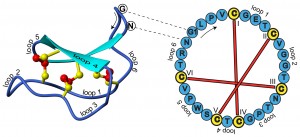 This one appeals to the six year old in me, which many who know me claim is barely hidden by the flimsiest of covers (if at all). Here is a parasitic fungus that infects ants. The infected ant wanders away from its nest; the ant then reaches a leaf or another plant part. The fungus makes the ant to bite the leaf so powerfully, it hangs from the leaf until it eventually dies; and then (excited-by-gross-stuff six-year old emerging): the fungus grows an upside down stalk out of the dead ant’s head, releasing spores that fall to the ground. The spores are then picked up by ants that walk over them, causing them to wander away from the nest, bite other leaves… Ad nauseam. Wow.
This one appeals to the six year old in me, which many who know me claim is barely hidden by the flimsiest of covers (if at all). Here is a parasitic fungus that infects ants. The infected ant wanders away from its nest; the ant then reaches a leaf or another plant part. The fungus makes the ant to bite the leaf so powerfully, it hangs from the leaf until it eventually dies; and then (excited-by-gross-stuff six-year old emerging): the fungus grows an upside down stalk out of the dead ant’s head, releasing spores that fall to the ground. The spores are then picked up by ants that walk over them, causing them to wander away from the nest, bite other leaves… Ad nauseam. Wow.
Briefly, once infected, the ant’s behavior is hijacked to act as a delivery system for the fungus, which is finding a good location to die and infect more ants.
Ants biting the underside of leaves as a result of infection by O. unilateralis. The top panel shows the whole leaf with the dense surrounding vegetation in the background and the lower panel shows a close up view of dead ant attached to a leaf vein. The stalk of the fungus emerges from the back of the ant's head and a bulb, the perithecia, from which spores are produced, grows from one side of this stalk, hence the name unilateralis. Reproduced under CC from PloS ONE
Nevertheless the ants have developed behaviors that protect them from infection. The fungus infects on the ground, so the ants build their nest in the forest canopy. They also forage in the canopy Although the canopy contains less food than the ground, the canopy is safer. Still , there are a few ant trails leading to the ground, where the spores of the horrible head-splitting fungus lurk.
There is an idiom in Hebrew: “avodat nemalim” or Ant’s work. It means a repetitive task that requires precision and takes a long time. Pontoppidian and colleagues have done exactly that: they selected a swath of 1200 m2 in the Thai jungle, and looked under each and every leaf there; how is that for “Ant’s work”? They discovered something quite bizarre: the ants clustered in “graveyards”: there were areas where there were considerably more dead ants. Also, within those graveyards there were even denser clusters. Below is a schematic showing the ant nests locations (in the canopy), the foraging area in the canopy (orange), the ant trails in the canopy and on the ground, and the graveyards are marked as green circles, with the denser clusters marked in darker green inside.
It is not clear why the dead ants cluster in those graveyards. Is it just a result of the nests’ locations? Or is it yet another fungus-induced modification of the infected ants’ behavior that somehow benefits the fungus? The researchers found some correlation between the graveyards’ locations and microclimatic conditions, but nothing that would immediately explain the existence of graveyards. Those clusters of dead ants with fungi sticking out of their heads are still a mystery.
Excerpt from a documentary about Cordyceps. Different species of fungus and ant though.
Pontoppidan, M., Himaman, W., Hywel-Jones, N., Boomsma, J., & Hughes, D. (2009). Graveyards on the Move: The Spatio-Temporal Distribution of Dead Ophiocordyceps-Infected Ants PLoS ONE, 4 (3) DOI: 10.1371/journal.pone.0004835


































